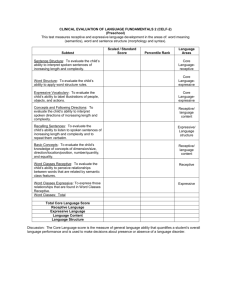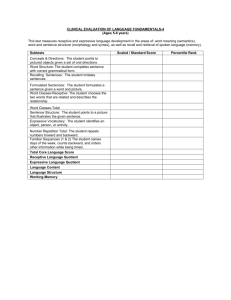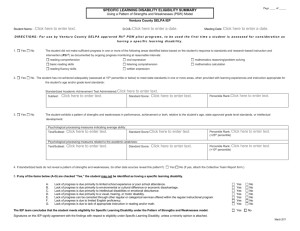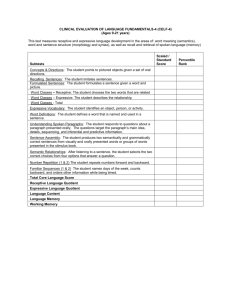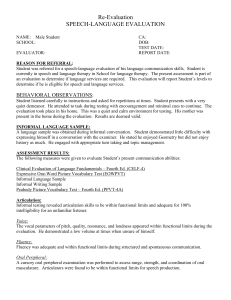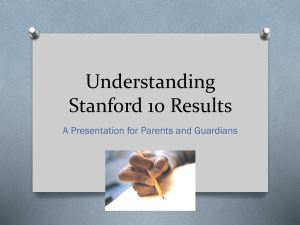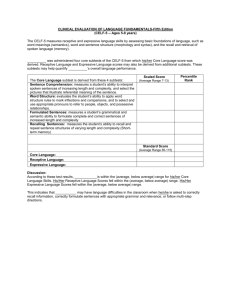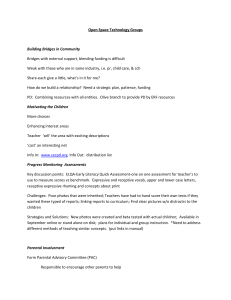Head Start Evaluation Template
advertisement
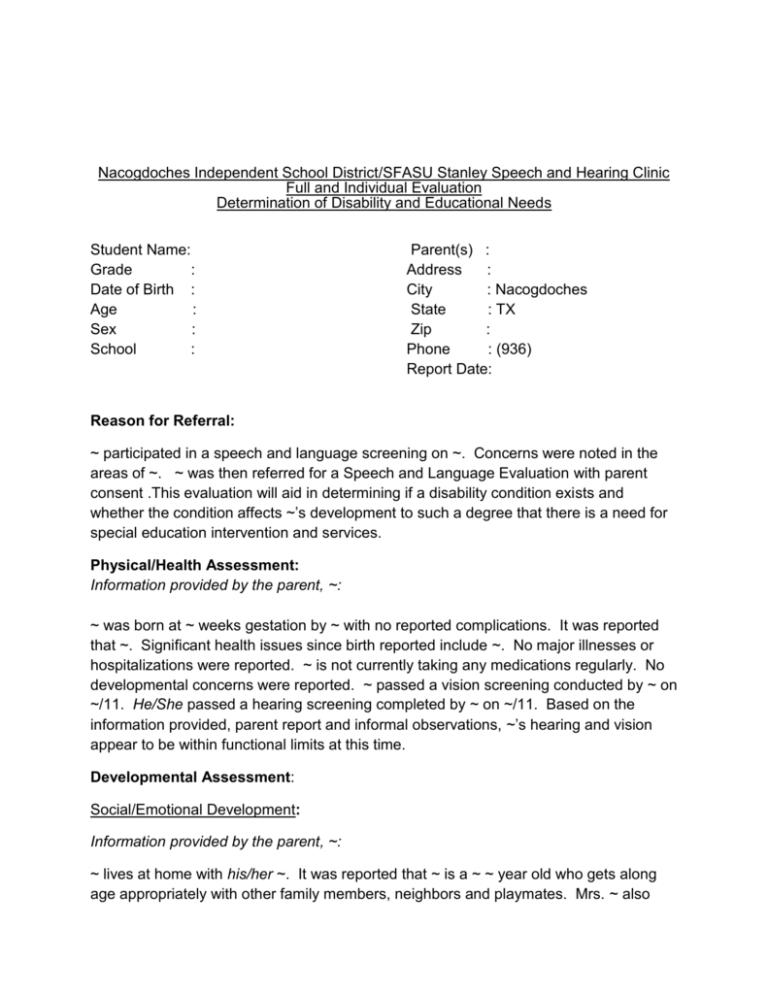
Nacogdoches Independent School District/SFASU Stanley Speech and Hearing Clinic Full and Individual Evaluation Determination of Disability and Educational Needs Student Name: Grade : Date of Birth : Age : Sex : School : Parent(s) : Address : City : Nacogdoches State : TX Zip : Phone : (936) Report Date: Reason for Referral: ~ participated in a speech and language screening on ~. Concerns were noted in the areas of ~. ~ was then referred for a Speech and Language Evaluation with parent consent .This evaluation will aid in determining if a disability condition exists and whether the condition affects ~’s development to such a degree that there is a need for special education intervention and services. Physical/Health Assessment: Information provided by the parent, ~: ~ was born at ~ weeks gestation by ~ with no reported complications. It was reported that ~. Significant health issues since birth reported include ~. No major illnesses or hospitalizations were reported. ~ is not currently taking any medications regularly. No developmental concerns were reported. ~ passed a vision screening conducted by ~ on ~/11. He/She passed a hearing screening completed by ~ on ~/11. Based on the information provided, parent report and informal observations, ~’s hearing and vision appear to be within functional limits at this time. Developmental Assessment: Social/Emotional Development: Information provided by the parent, ~: ~ lives at home with his/her ~. It was reported that ~ is a ~ ~ year old who gets along age appropriately with other family members, neighbors and playmates. Mrs. ~ also reported that ~ enjoys playing with ~. He/She also reported that ~ responds appropriately to discipline. Cultural and/or lifestyle factors do not appear to influence ~’s learning at this time. There does not appear to be a lack of educational opportunities at this time. Communication and Language Assessment: Language Development: Information provided by the parent, ~: ~’s Home Language survey was completed on ~. The language survey indicated that currently his/her dominant language is English and that he/she expresses himself/herself best orally. Based on this information regarding his/her language abilities, the remainder of the evaluation was conducted in English. ~ reported no concerns/concerns with ~ Information provided by the assessment: ~ was evaluated by a graduate student clinician under the direct supervision of a licensed Speech Language Pathologist in the areas of language and articulation using informal as well as standardized measures. He/She interacted with the clinician throughout the assessment and complied willingly with directives given to him/her. Test Conditions and Behaviors: Testing was conducted using standard procedures. Conditions for this testing session were considered to be adequate. Distractions were minimal and insignificant at this time. Rapport was established and maintained adequately for testing. Adequate eye contact was achieved and maintained during testing. In general, ~~ appeared cooperative during testing and did appear to exert an effort to respond appropriately. Overall, the examiner felt that the results of this test were a valid estimate of current functioning abilities in this area. ~~ did/did not wear glasses or hearing aids during testing. Information provided by the parent, ~: Mrs. ~ reported ~. Information provided by the assessment: PRESCHOOL LANGUAGE SCALE-5 The Preschool Language Scale-5 (PLS-5; Zimmerman, Steiner & Pond, 201) is a revision of the Preschool Language Scale-Fourth Edition (PLS-4). The PLS-5 is an individually administered instrument that assesses receptive and expressive language skills in infants and young children birth through 7 years, 11 months. The PLS-5 provides age equivalents and standard scores for the subscales of Auditory Comprehension and Expressive Communication, as well as for Total Language. Examiner: ~, SFASU Graduate Student Clinician ~, MS, CCC/SLP Date of Exam: ~/11 Auditory Comprehension Raw Score: Standard Score: Percentile Rank: Age Equivalent: Expressive Communication Raw Score: Standard Score: Percentile Rank: Age Equivalent: Total Language Score Raw Score: Standard Score: Percentile Rank: Age Equivalent: The Auditory Comprehension Subscale was used to evaluate ~’s receptive language skills in the areas of attention, semantics, structure, and integrative thinking skills. Results yielded a raw score of ~ which converted to a standard score of ~ placing ~ in the ~ percentile. His/her performance was (within normal limits or ~standard deviations below the mean/above the mean) when compared to the performance of children the same chronological age and indicated a (mild, moderate, severe) receptive language disorder or indicated the presence of age appropriate receptive language skills. Strengths included ~. Weaknesses included ~. The Expressive Communication Subscale was administered to addresses the areas of vocal development, social communication, semantics, structure, and integrative thinking skills. Results yielded a raw score of ~ which converted to a standard score of ~ placing~ in the ~ percentile. His/her performance was (within normal limits or ~standard deviations below the mean/above the mean) when compared to the performance of children the same chronological age. Results yielded a raw score of ~ which converted to a standard score of ~ placing~ in the ~ percentile. His/her performance was (within normal limits or ~standard deviations below the mean/above the mean) when compared to the performance of children the same chronological age and indicated a (mild, moderate, severe) expressive language disorder or indicated the presence of age appropriate expressive language skills. Strengths included ~. Weaknesses included ~. The Total Language results represent a combination of the Auditory Comprehension and Expressive Communication subscales to provide an overall assessment of language skills. Results yielded a raw score of ~ which converted to a standard score of ~ placing~ in the ~ percentile. His/her performance was (within normal limits or ~standard deviations below the mean/above the mean) when compared to the performance of children the same chronological age and indicated ~ Speech Development: Information provided by the parent, ~: ~ was reported to use ~. He was reported to use ~. Information provided by the assessment: GOLDMAN-FRISTOE TEST OF ARTICULATION - 2 The Goldman Fristoe Test of Articulation-2 (GFTA-2; Goldman & Fristoe, 2000) is an individually administered instrument that provides a systematic measure of articulation of the consonant sounds in simple and complex contexts. The GFTA-2 is divided into three subtests: Sounds-in-Words, Sound-in-Sentences, and Stimulability. Norms are provided for ages two through 21. The number of errors on the Sounds-In-Words subtest can be converted to standard scores with a mean of 100 and a standard deviation of 15. Examiner: ~, SFASU Graduate Student Clinician ~, MS, CCC/SLP Date of Exam: ~/11 Sounds-In-Words Subtest: ~ was given the Sounds-In- Words Subtest of the Goldman Fristoe Test of Articulation 2 in order to assess ~’s articulation skills at the single word level. Results were as follows: Substitutions: Initial position: Medial position: Final position: Omissions: Initial position: Medial position: Final position: Distortions: Initial position: Medial position: Final position: Raw Score: Standard Score: Percentile: Test-Age Equivalent: On the Goldman-Fristoe Test of Articulation-2, Sounds-in-Words subtest, ~ exhibited ~ sound errors on the items administered. He/she obtained a standard score of ~placing him/her in the ~percentile when compared with other children his/her same chronological age. These scores indicated ~’s articulation skills (were within normal limits/ the presence of a mild/moderate/severe articulation disorder) Sounds-in-Sentences Subtest: The Goldman-Fristoe Test of Articulation-2, Sounds-in-Sentences subtest was administered to sample articulatory skills in connected speech. A total of ~ sound errors were recorded on this subtest. Sampled errors in connected speech were approximately the same as those recorded in isolated words. The errors noted were ~ Oral Facial Examination: An oral facial examination was administered in order to evaluate the structure and function of ~’s oral mechanism. (include findings from form…facts about structure first, then facts about function, and judgment about whether or not the oral mechanism is adequate for the normal production of speech…use example below as a guide) ex: ~’s lips and tongue were found to be of normal size, shape and symmetry. The relationship of the mandible to the maxilla was within normal limits. The soft palate appeared to be within normal limits. However, the hard palate was extremely high and narrow. ~ was able to protrude and retract his lips in rapid succession. He elevated, depressed protruded, retracted and lateralized his tongue. Velopharyngeal closure was assessed on production of /a/ and found to be within normal limits. Diadochokinetic rate was within normal limits. All structures and functions of ~’s oral mechanism were judged to be adequate for the normal production of speech. Sensori-Motor Assessment: According to parent information, teacher information and informal observation, fine and gross motor areas appear to be commensurate with his/her age. Mrs. ~ reported no concerns with motor development at this time. Adaptive Behavior Assessment: Adaptive behavior was assessed informally using parent and teacher information. ~’s overall adaptive behavior is commensurate with his/her age. It was reported that ~ can perform all skills age appropriately with the exception ~. Assistive Technology Needs: Assistive technology was assessed informally using parent information and observation. There are no indications that ~ is in need of the use of any assistive technology in order for him/her to benefit from the educational environment. Summary/Determination of Disability: ~ is a ~ year, ~ month old ~ who participated with good effort throughout the assessment. Environment was appropriate for testing and results are considered to be a valid indicator of ~ ability. According to the assessment results, ~’s receptive and expressive language skills appear to be ~ at this time. ~ articulation skills appear to be ~ at this time. Vocal parameters, fluency, and orofacial structure were informally observed and appear to be adequate for the production of speech. Based on the data above, ~ does/does not appear to meet eligibility criteria as a student with a Speech Impairment in the area of ~ at this time. The ARDC will make the final determination of the eligibility for special education based on the student’s education services. Recommendations for the Admission Review Dismissal Committee (ARDC): Provide speech therapy to target the ~. Provide a home program to assist in the remediation of targeted concepts. Assurances: The Multidisciplinary Team assures that: ____ Tests, or evaluation materials, and procedures used for the purposed evaluation were selected and administered so as not to be racially or culturally discriminatory. ____Any standardized tests have been validated for the specific purpose for which they were used. ____Any standardized tests were administered by trained personnel in conformance with the instructions provided by their producers. ____ More than one procedure was used for determining whether a student has a disability and for determining an appropriate educational program for the student ____ Tests were selected and administered so as best to ensure that if a test was administered to a child with impaired sensory, manual, or speaking skills the test results accurately reflect the student's aptitude or achievement level or other factors the test purports to measure, rather than reflecting the student's impaired sensory, manual, or speaking skills (unless those skills are the factors that the test purports to measure). ____Technically sound instruments were used to assess the relative contributions of cognitive and behavior factors, in addition to physical or developmental factors. ____The evaluation provides relevant information that directly assists persons in determining the educational needs of the child. _N/A_ Materials and procedures used to assess a student with limited English proficiency were selected and administered to ensure that they measure the extent to which the student has a disability and needs special education, rather than measuring the student's English language skills. ____ Information has been drawn from a variety of sources such as aptitude and achievement tests, parent input, teacher recommendations, physical condition, social or cultural background, and adaptive behavior. Signature of Core Evaluation Team Members: _______________________________ ~, MS, CCC/SLP Speech Language Pathologist ~, 2011 _______________________________ ~ SFASU Graduate Student Clinician ~, 2011

